In the third part of the article, adriaticnature dealt with the representatives of the Sparidae family (sea breams), which are quite often caught with a spinning, float and another tackle. However, an enormous number of fishes, which are rather easily caught, inhabit the coastal zone. Every single one, regardless of merit and rank, is extremely delighted to catch any, even tiny, fish. People are often lost for words and can’t describe the pleasure of bringing back a small trophy into the native element.

(The 34th US President Dwight Eisenhower fishing with the guide. Photo © AMFF. news.orvis.com)
We often go on vacation with our children, and we can’t hide the pleasure we get, when they take us to the seaside to catch at least one small fish with a fishing rod or light spinning tackle. And, indeed, there is a considerable amount fish in the Adriatic Sea.
In this part of the article, adriaticnature will try to provide information on small fishes, which either are caught from the shore with quite the same frequency, regardless of the season and without any special effort, or abundantly inhabit the area near the shore all year round.
Small soft plastic lures on light jig heads, as well as small pieces of mollusks and other heads attract representatives of the Labroidei suborder. More than 20 representatives of this suborder inhabit the Adriatic Sea. Most of them are medium-sized multi-colored fish, usually not more than 20 centimeters long, that inhabit the coastal zone. The following species of these cute fish are most often caught:
East Atlantic peacock wrasse. Males of this fish are brighter than females. East Atlantic peacock wrasse can be up to 40 centimeters long. Specimens up to 20-25 centimeters are more common.
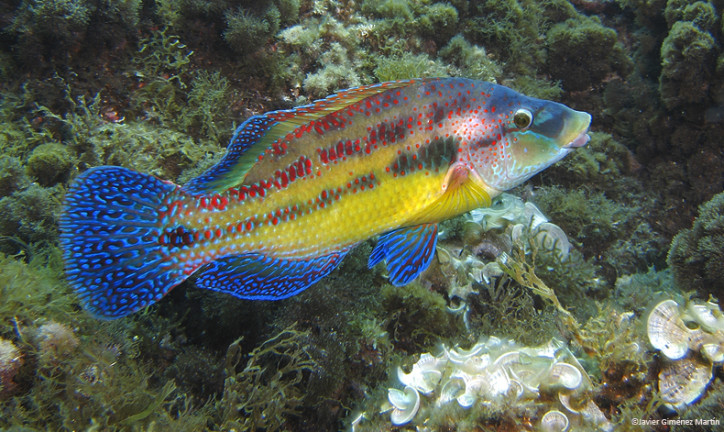
(East Atlantic peacock wrasse male. Photo by © Giménez Martín. fotodenaturaleza.com)
East Atlantic peacock wrasse inhabit the depths of up to 50 meters. They usually swim near the rocky bottom in the sea grass bed close to the shore. They feed on mollusks, shrimps, crabs and other living creatures.

(East Atlantic peacock wrasse female. Photo © ffessmbiologie.free.fr)
These beautiful multi-colored small fish are rather trusting and often take various baits, anything including bread crumb to small plugs.
Numerous relatives of wrasses, such as ocellated wrasses, corkwing wrasse, axillary wrasse, and other wrasse representatives that have similar habitats and diets, are similar to them to a certain degree.

(Ocellated wrasse male. Photo by © Dalibor Andres. wildcroatia.net)
However, some species of the suborder, the permanent inhabitants of the Adriatic Sea, have a very peculiar look.
Schools of small dark fish often occur in the blue near the rocky coasts and piers close to quite deep water. Damselfishes can be up to 25 centimeters long, but usually they rarely exceed 10-14 centimeters.
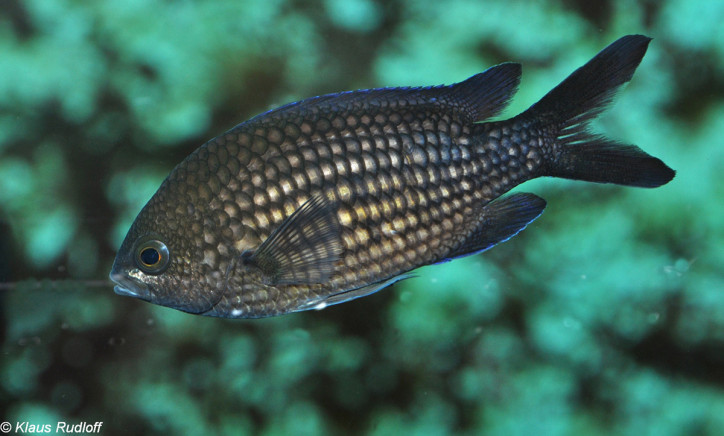
(Damselfish. Photo by © Klaus Rudloff. biolib.cz)
Damselfishes inhabit the blue above the rocky bottom and vegetation beds at the depths of up to 40 meters. They feed on zooplankton and small invertebrates. Fishermen catch this fish using various lures of natural origin.
Mediterranean rainbow wrasse males are brighter than coris females, as well as other wrasses. Mediterranean rainbow wrasses can be up to 30 centimeters long. Specimens up to 20 centimeters long are more common.
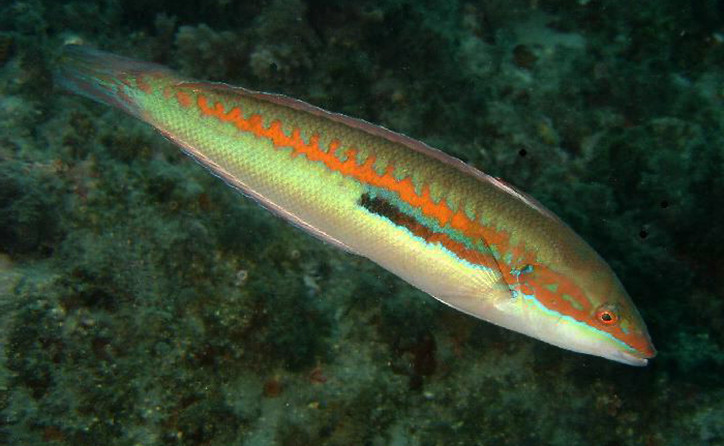
(Mediterranean rainbow wrasse. Photo © blog.mallorcahiking.com)
These small fish are sequential hermaphrodites: females become males during their lifetime. They change both sex and color. Another peculiar feature of mediterranean rainbow wrasses is that they have sharp small teeth that drive fishermen, who use spinning rods and soft plastic lures as ultra-light tackle, crazy. These fish bite off lure tails quite often.
Usually, mediterranean rainbow wrasses inhabit the depths of up to 60 meters. They prefer to swim close to the rocky bottom covered with aquatic vegetation. They feed on small gastropods, sea urchins, worms and other marine organisms.
Ornate wrasse is one of the most beautiful representatives of the Labride family.
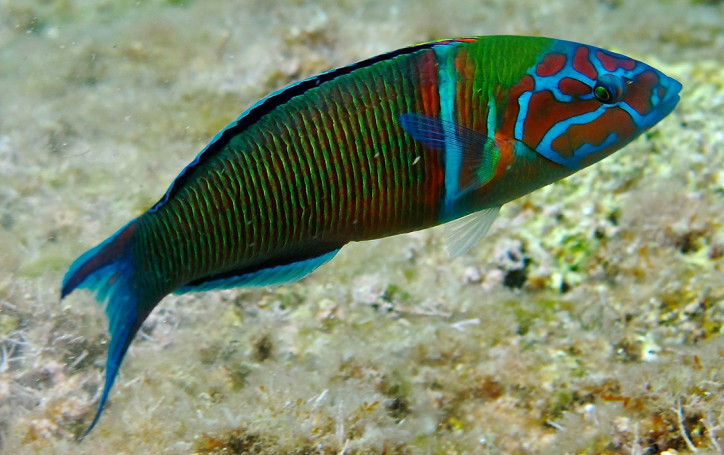
(Ornate wrasse. Photo by © Simon Brandl. scimonopsis.com)
Ornate wrasses inhabit the depths of up to 50 meters. They prefer to swim close to the rocky bottom in the sea grass bed. It can be up to 25 centimeters long, feeds on small mollusks and crustaceans.
Small predators, which are ready to eat almost any medium-sized lure, including soft plastic, miniature plugs and jigs, pieces of meat and worms, inhabit water near the shore, hiding under stones, in the crevices of piers and embankments. There are more than 50 species of the Gobiidae family in the Adriatic Sea. Some of them are only a little more than a centimeter long. Others can be 30 centimeters long.
Giant goby is one of the largest gobies in the Adriatic.
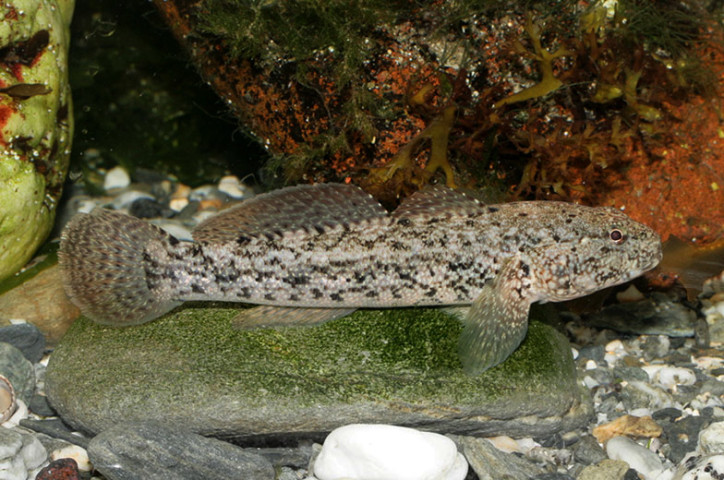
(Giant goby. Photo by © Michelle Stuart. fishtanksandponds.co.uk)
Giant gobies inhabit the depths of up to 35 meters near a rocky bottom covered with aquatic vegetation. They often swim close to the river mouths. They can be up to 27 cm long, feed on crustaceans, worms and small fish.
Black gobies, which can be up to 18 centimeters long, often attack lures as well.

(Black goby. Photo by © Lauri Urho. luontoportti.com)
They inhabit the depths of up to 50 meters. They often swim near the river mouths as well, preferring sandy and muddy bottom covered with aquatic vegetation. They feed on crustaceans, mollusks, small fish.
It’s difficult to mistake gobies for other representatives of the ichthyofauna. Although, some similarities to the species of the Blenniidae family (about fifteen species inhabit the Adriatic) can be found. The most frequently caught blenny is rusty blenny.
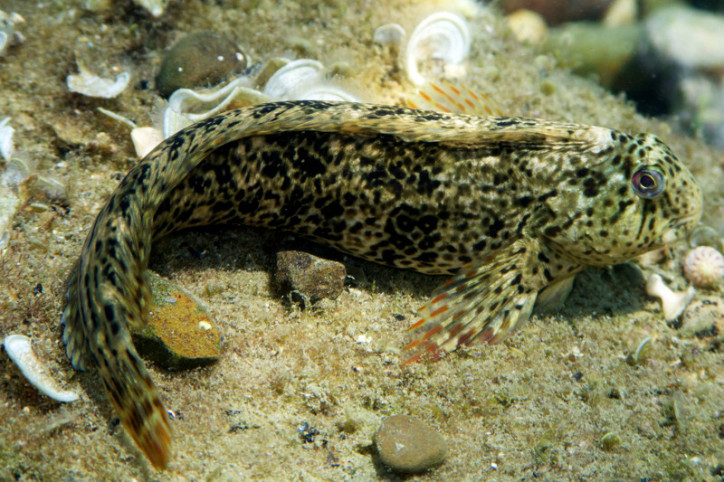
(Rusty blenny. Photo © tokaiki.net)
Rusty blennies can be up to 18 centimeters long. They are omnivorous, like gobies. However, they are more slow and thoughtful. They inhabit the depths up to 1.5-3 meters, preferring a sandy bottom with stones and algae growing nearby.
Most fishes of the Labroidei suborder, the Gobiidae and Blenniidae family have a near-bottom lifestyle. Beside these harmless inhabitants of the bottom, chances are high that fishermen come across other kinds of fish that can get them into trouble. adriaticnature has already mentioned them in the article “Dangerous Inhabitants of the Adriatic Sea. Fish”, but in another context.
In the course of shore fishing on vacation, chances are high that you catch small beautiful fish of the Scorpaenidae family. One should beware of pricks of the spikes located in dorsal, anal and pectoral fins which contain venom. Small red scorpionfish are often caught.
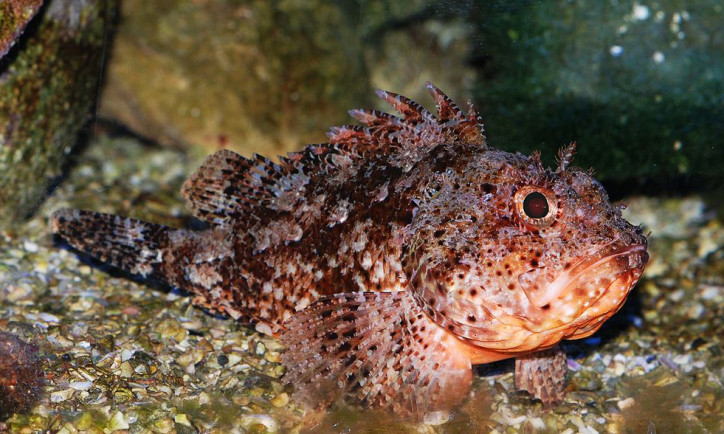
(Small red scorpionfish. Photo by © Dein Freund der Baum. en.wikipedia.org)
They usually swim near the rocky bottom close to the shore, but they can also be found at the sandy and rocky bottom. They can be up to 24 centimeters long. Specimens up to 12 cm long are more common. They feed on crustaceans and small fish. Most small red scorpionfishes are crepuscular predators. Nevertheless, they can be often caught with medium-sized lures on a sunny hot day.
A close relative of the small scorpionfish – black scorpionfish – is regularly caught by fishermen.

(Black scorpionfish. Photo by © Achille De Sanctis. fisbase.org)
Black scorpionfish is slightly larger than small scorpionfish, but specimens up to 15 cm long are more common. It feeds on small fish, crustaceans and other invertebrates.
However, the most unpleasant fish that can be caught are representatives of the Trachinidae family. They look sweet and harmless. Nevertheless, their venom hidden in spikes on the operculum and dorsal fin is much stronger than the venom of scorpionfishes. Moreover, unlike scorpionfishes, they are much more active, when they are on shore. Their usual habitats are sandy beaches and other sand-bottomed parts of the sea.
Lesser weever is an ordinary member of the family.
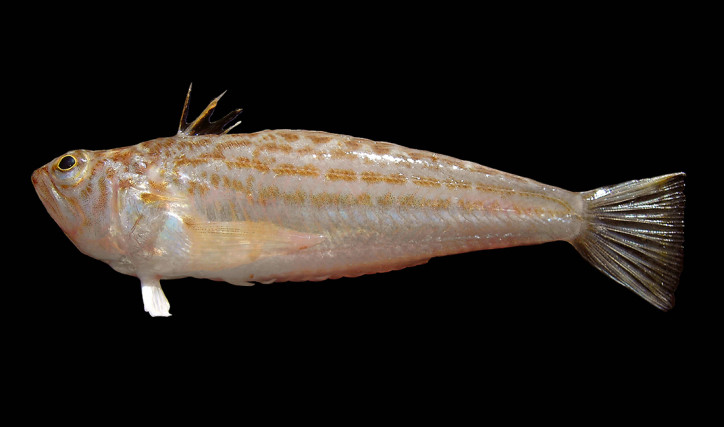
(Lesser weever. Photo by © Hans Hillewaert. flickr.com/photos/bathyporeia)
Lesser weevers can be up to 15 centimeters long. They feed on worms, crustaceans, mollusks and small fish, that is, it’s almost omnivorous. This is the reason why chances are high that you catch them with various lures.
Greater weever inhabits sandy bottom areas as well. Its size may be rather impressive – more than half a meter long. However, fish that aren’t longer than 20–25 centimeters are usually caught. They attack medium-sized soft lures, jigs and lures of natural origin regularly.

(Greater weever. Photo by © Hans Hillewaert. flickr.com/photos/bathyporeia)
Weevers should be treated carefully, when you get them off the hooks. And you should be very careful in situations, when you decide to spend time fishing with children.
Representatives of the Triglidae family, commonly known as sea robins or gurnard, are harmless relatives of scorpionfishes. They are amazing and unusual fish that are often caught with all kinds of medium-sized lures. In addition to splendid pectoral fins, which look like multicolored wings, their three lower rays turned into long moveable spurs used by sea robins to move along the bottom in search of food. Besides, once on shore, these fish make quite loud sounds, like rumbling.
There are several species of sea robins in the Adriatic Sea. Streaked gurnard is one of the usual representatives of the family.

(Streaked gurnard. Photo by © Tony Gilbert. flickr.com/photos/tonyjgilbert-images)
Streaked gurnard prefers to keep close to the rocky and sandy bottom at the depths of 5-10 meters. Specimens up to 30 centimeters long are more common. It feeds mainly on crustaceans.
Grey gurnard is a common representative of the family. It inhabits areas near the rocky and sandy bottom.
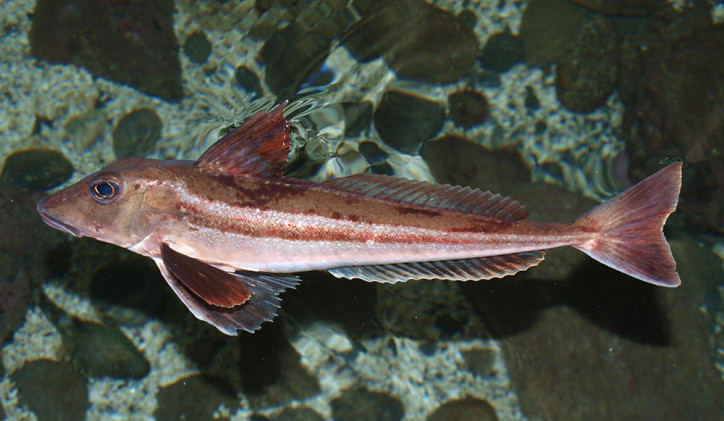
(Grey gurnard. Photo by © Olve Utne. alnakka.net)
In case of shore fishing, fish up to 30 cm long are more common. They feed on shrimps, crabs and small fish.
Fish, the shape of the body and the coloring of which vaguely resemble weevers, are very frequently caught. Moreover, they often inhabit the same places as weevers – the coastal areas of the sea with a sandy bottom. And if there are stones and underwater vegetation nearby, Atlantic lizardfishes are definitely there.
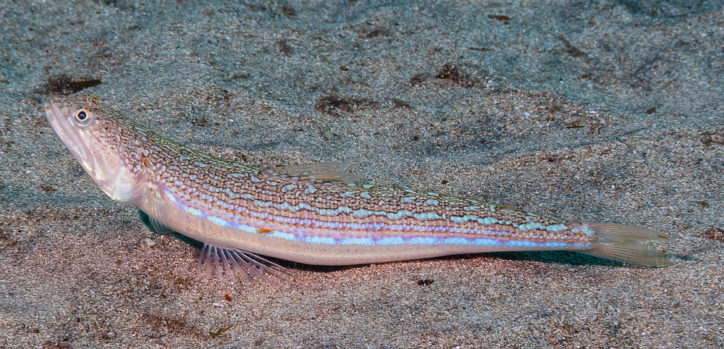
(Atlantic lizardfish. Photo by © zsispeo. flickr.com/photos/zsispeo)
Indeed, their head and body shape resemble reptiles. In contrast to venomous weevers, lizardfishes are absolutely harmless. They can be up to 40 centimeters long, but fish up to 20-25 centimeters long are more common.
All the ichthyofauna representatives described above, except for damselfishes, have a near-bottom lifestyle. But mullets, schooling fish, can be found in almost any water layer. Six species of mullets inhabit the Adriatic Sea. Most of them feed on small benthic organisms and plant food. Predatory tendencies are rarely manifested. Typically, mullets are caught using a float fishing rod and bread crumbs as baits. Various flavoring agents are occasionally used as well.
Mullets are similar to each other. However, according to many fishermen, golden grey mullet is one of the most “noble” representatives of the mullet family.

(Golden grey mullet. Photo by © Pedro Niny Duarte(c)ImagDOP. fishbase.org)
Golden grey mullet can be up to 60 cm long. Specimens up to 30 cm are more common. Adult individuals keep to the depths of more than 10 meters, entering bays, estuaries and lagoons. They feed on small benthic organisms, detritus, and sometimes insects and plankton.
Once again, if you descend closer to the bottom, you can find lively predatory small fish belonging to the Serranidae family. They have “older brothers” – groupers, which reach more than impressive sizes. But in the coastal zone, three species of the same genus of the Serranidae, most often respond to artificial lures and all kinds of baits of animal origin.
Brown comber is the smallest representative, but it’s no less predatory and active than its “big brothers”.
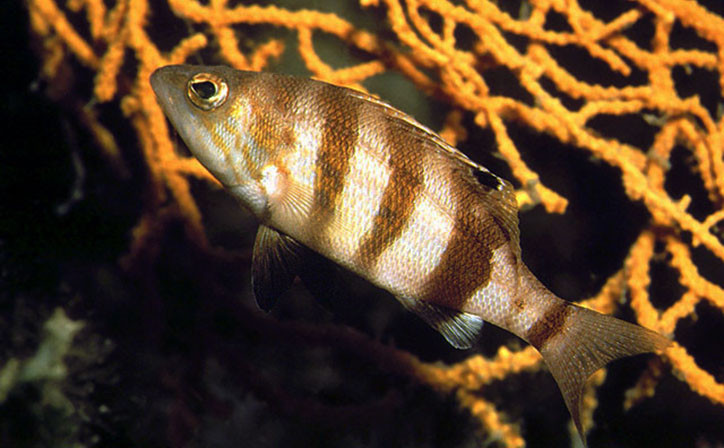
(Brown comber. Photo by © Robert A. Patzner. fishbase.org)
Brown comber can be up to 25 centimeters long, but it is rarely longer than 15 centimeters. It inhabits the depths of up to 100 meters and sticks close to the sandy or muddy bottom amidst the rocks and sea grass bed. It feeds on crustaceans, mollusks and small fish.
Painted comber is another member of the genus. It brings a lot of fun, when playing with light tackle. Moreover, it pleases with its look. A bright blue spot on its belly makes you think that an unknown underwater artist decided to repaint a bright striped fish, but quit soon because he got carried away by another fish.

(Painted comber. Photo by © Josep Vilanova. sealifecollection.org)
Painted comber inhabits the depths of up to 30 meters near the rocky bottom, often hiding in the sea grass bed. It can be up to 36 centimeters long. It feeds on fish and crustaceans.
Comber is the largest representative of the genus of the Serranidae, preferring high seas and often rocky shores.

(Comber. Photo by © B.E. Picton. habitas.org.uk)
Comber inhabits the depths of up to 500 meters, sticking to rocky, less often sandy and muddy bottom. It can be up to 40 centimeters long. It feeds on fish, cephalopods and crustaceans. It is caught with all sorts of lures, but catching it with medium-sized jigs using a light spinning kit brings special pleasure.
However, in the course of the near-bottom shore fishing for combers with medium-sized jigs, their older brothers, groupers, are likely to attack your lure. adriaticnature will deal with them in the next part of the article.